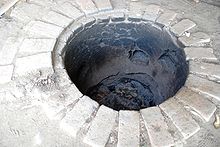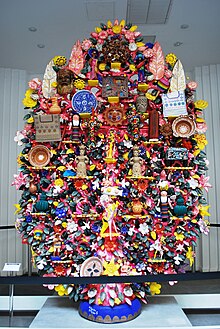Mexican ceramics
All pre-Hispanic figurines, since they were almost always related to religion, disappeared and replaced by images of the Virgin Mary, angels, friars, soldiers, devils and European farm animals such as dogs, cattle and sheep.[11] For the rest of the colonial period, indigenous styles continued to deteriorate all over New Spain, while foreign influences from Europe, Asia and the Middle East produced changes in decorations.Superstition may surround the process, especially firing, with potters taking care to avoid "the evil eye" of neighbors and building small shrines and performing Christian and indigenous blessings.The kind of temper used varies on location, from cattail fluff in Metepec, to sand in Acatlán or kapok in Ameyaltepec to give the clay the right consistency and it keep the final product from cracking.Both indigenous and European pottery traditions employ decoration, which can vary from simple color changes to elaborate images and designs painted on and/or pressed into the piece.Cooperatives such as these have attracted the attention of Japanese ceramists and billionaire financier Alfredo Harp Helú, who have provided seed money, business advice and outlets to show their wares internationally.[36][37] While the Doña Rosa's techniques and designs are now widely copied in Oaxaca, the original workshop still exists, with her son Valente Nieto Real still making pieces at seventy years of age.[19] From the 1980s to the present, an artisan named Carlomagno Pedro Martinez has promoted items made this way with barro negro sculptures, which have been exhibited in a number of countries.[39] Atzompa's pottery tradition prior to the Conquest is similar to other settlements in the area,[40] but after the Spanish introduced glazing techniques the green variation was adopted and has changed little since.[41] Despite the development and introduction of lead-free glazes,[41] Atzompa continues to have some of the highest lead content in Mexico, found both in the wares and in the potters and other people who live there.The oldest son, Luis García Blanco makes figures called "muñecas bordadas" (embroidered dolls) with long skirts that reach the floor, eliminating the need to create breakable feet.The most distinctive aspect are the figures of women, which average about a meter tall and have on their heads a shallow pan of sand to set a water storage jar.[49] High fire wares like alta clay and stoneware were introduced to the area by American Ken Edwards and Mexican Jorge Wilmot starting in the 1960s.The institution was begun when a board of local artisans and businessmen with sculptors Jorge Wilmot and Ken Edwards to find a way to promote the ceramic tradition here.Artists and artisans represented include Salvador Vásquez, Juan Antonio Mateo, Gerónimo Ramos, Nicasio Pajarito, Candelario Medrano, Jorge Wilmot and Ken Edwards.[56] In Santa Cruz de la Huerta, near Tonala, specializes in clay drainpipes, some crudely fashioned toys and whistles in the shape of animals.In his workshop can be found double decked boats, church buildings with miniature people, and animals such as lions, roosters and owls with savage human faces.Principle makers in Guanajuato city are Gorky Gonzalez, who maintains traditional designs, and the Alfarería Capelo Mayolica, which produces large pieces with more intense and darker colors.Juan's father, Fortino, makes pottery with a plain reddish base and decorated with two tones of green glaze allowed to dribble down the sides.[62] Authentic Talavera pottery only comes from the city of Puebla and the nearby communities of Atlixco, Cholula, and Tecali, because of the quality of the natural clay found there and a tradition of production that dates to the 16th century.[64] Production of this ceramic became highly developed in Puebla because of the availability of fine clays and the demand for tiles from the newly established churches and monasteries in the area.The industry had grown sufficiently that by the mid-17th century, standards and guilds had been established that further improved the quality, leading Puebla into what is called the "golden age" of Talavera pottery (from 1650 to 1750).[66] In the northern part of Puebla state, most notably in the municipalities of Aquixtla and Chignahuapan, Nahuatl-speaking indigenous peoples produce cooking utensils such as comals, pitchers, pots and more with a glazed finish.[70] Quiroga sells big, black glazed pitchers and water jugs with relief scenes, mostly depicting the Danza de los Viejitos.[77] The village of Juan Mata Ortiz is located along the banks of the Palanganas River near Nuevo Casas Grandes in the high northern plains of Chihuahua.[79][80] Unlike a number of revivals of pottery traditions in Arizona and New Mexico, this renewal of an ancient art was done by one of the village residents without any help initially from archeologists or museums.[81] States along the Gulf coast, such as Veracruz, Tabasco, Campeche and Yucatán have centers associated with pottery but most of these produce to serve local needs and much of the work used to be done solely by women.[82] Pre-Columbian Mexico had a great tradition for thousands of years of making sculptures and figurines in clay, much of which was lost during the Spanish colonization of the Americas and Mexican Colonial period.For many people living in rural Oaxaca economic options are limited to subsistence farming, working in Mexico City or illegally migrating to the United States.[85] Barro sin Plomo, an organization related to the World Bank, has had success in exporting lead-free pottery items to the United States and says that the market outlook for these products is optimistic.


























State of HidalgoMuseo de Arte PopularMexico CityPre-Columbianceramic artspotteryMesoamericaburnishedfine clay slipspotter's wheelSpanish Invasion and Conquestcomalsfolk artTalaveraPueblamajolicaGuanajuatoGuadalajarabarro negroMata Ortiz or PakiméChihuahuaMexican economyMexican cultureWestern Mexico shaft tomb traditionAnahuacalli MuseumtemperGulf CoastCarlomagno Pedro MartinezSan Bartolo CoyotepecOaxacaZapotecspinch potscoiled potsTlaxcalaglazedEarly Post Classic periodmolcajetescensersVirgin Maryfriarsolive jarsAguascalientesMexican War of IndependenceNew WorldDelftwarecantaroFONARTnon-governmental organizationsTrees of Lifebarro negro potterycattailMetepecAcatlánfeldsparstonewareJorge WilmotCuernavacamagic realismRufino TamayoFrancisco ToledoAlfredo Harp Helú"barro negro"green-glazed pieces of Santa María AtzompaMonte AlbánSanta María Atzompalead monoxideBlanco familyTeodora Blanco NúñezOcotlán de MorelosJosefinaTehuantepecCeramics of JaliscoTonaláTlaquepaqueMexican flagpetatescinnamonkaolinnativity scenesnahualSan Pablo del MonteNicasio PajaritoDolores HidalgoSan Miguel AllendeCoroneoAtlixcoCholulaTecaliTalavera de la ReinamonasteriesguildsChignahuapanNahuatlIzúcar de MatamorosDay of the DeadcharroLa Calavera CatrinaMichoacánLake PátzcuaroTzintzuntzanfretworkSanta Fe de la LagunaSan José de GraciaDanza de los ViejitosCapulaMoreliaState of MexicoalebrijesAlfonso SotenoAdam and EvepulqueIxtapan de la SalJuan Mata OrtizNuevo Casas GrandesApachesSpencer MacCallumArizona State MuseumMuseo de Arte Popular, Mexico CityHuejutla de ReyesHidalgoTabascoCampecheYucatánTlacotalpanMaya blueJaina Island